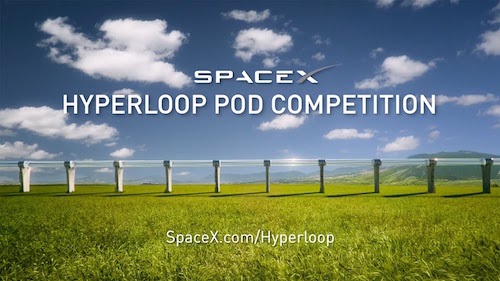
ANSYS is donating simulation software to teams participating in SpaceX’s Hyperloop pod design competition. Image Courtesy of SpaceX
Latest News
December 29, 2015
The Hyperloop, proposed by serial entrepreneur Elon Musk in 2013 as a radical, high-speed transportation concept, may no longer be the stuff of science fiction as it inches closer to becoming a working prototype.
Initially an alternative to California’s proposed high-speed bullet train railway system, Hyperloop is envisioned as a pneumatic tube-based transportation system that would initially connect San Francisco and Los Angeles, transporting people at speeds as fast as 700mph. Hyperloop’s design calls for reduced pressure tubes that house pressurized capsules (or pods) that would careen between destinations on an air cushion driven by linear induction motors and air compressors. Some liken the concept to air hockey table, on steroids, of course.
While Musk, of SpaceX and Tesla fame, put forth Hyperloop as a general concept, its development is pure open source with a handful of private sector companies and the general research and university community wading in to advance the design. For example, Hyperloop Technologies, focusing first on moving freight rather than people, is starting on-site testing this January in Las Vegas with plans to do a full-scale, full-speed test with over two miles of tube and a pod accelerated to over 700mph by end of 2016. Hyperloop Transportation Technologies is taking a crowdsourcing approach, courting engineers and architects to devote time and contribute ideas to its Hyperloop design via JumpStartFund. Musk himself committed to building a test track in California for piloting scaled-down capsules, and his SpaceX company is sponsoring a competition tasking participants to design and build a half-scale Hyperloop pod, which will culminate some time in June 2016.
 ANSYS is donating simulation software to teams participating in SpaceX’s Hyperloop pod design competition. Image Courtesy of SpaceX.
ANSYS is donating simulation software to teams participating in SpaceX’s Hyperloop pod design competition. Image Courtesy of SpaceX.The competition, designed to keep the Hyperloop design ball rolling, is getting an added boost from ANSYS, which is contributing simulation software for use on the design challenges. Competing teams will have broad access to the ANSYS simulation portfolio, including structural, fluid, electromagnetics and systems simulation capabilities, enabling them to virtually predict real-world outcomes for Hyperloop quickly and reliably.
“We’re really excited about this because it clearly shows the value proposition of engineering simulation,” noted Sandeep Sovani, ANSYS’ director for global automotive industry. “If you’re creating a completely new innovation of enormous proportion like Hyperloop, which is hundreds of miles long and running at extreme speeds, then testing that idea with physical prototyping is very difficult, costly and enormously time consuming. If you took simulation out of the picture, Hyperloop might not even be possible.”
Paul Andrew Witsberger, a senior at Purdue University’s College of Engineering and part of its Hyperloop team, said simulation is critical for helping to solve a problem that no one has solved before. “Many of the technical problems that we are trying to address can’t simply be solved by running a wind tunnel test,” he said. “FEA (finite element analysis) and CFD (computational fluid dynamics) have allowed us to perform rapid design iterations and analyze the impact of various pod configurations and layouts that we couldn’t have determined otherwise.”
The team’s key differentiator — its levitation system design, which uses air bearings to levitate — leaned heavily on ANSYS CFD simulations. “Without our simulation results from ANSYS, we would be otherwise unable to determine what happens in such a complicated flow regime,” Witsberger explained.
The HyperXite team, from the University of California, Irvine, said ANSYS is was instrumental in helping it evaluate multiple design iterations. “We are able to quickly proceed through analysis of multiple designs until we arrived at the design with the greatest benefits in ease of production, cost, and safety,” noted James Harvey, Levitation Lead for the HyperXite team. “Overall, the use of ANSYS decreased the need for physical experiments, reducing the time and cost of design.”
 Isometric view of the HyperXite pod design used for ANSYS simulation. Image Courtesy of the University of California, Irvine Hyperloop HyperXite team.
Isometric view of the HyperXite pod design used for ANSYS simulation. Image Courtesy of the University of California, Irvine Hyperloop HyperXite team.Select teams will build a physical prototype of their pod and test it next summer on a one-mile Hyperloop test track that SpaceX is constructing near its Hawthorne, CA, headquarters.
Hyperloop Technologies is also actively getting involved in the competition circuit, most recently as a sponsor of the SpaceX Hyperloop Pod Design Weekend at Texas A&M, to be held later in January. More than 100 teams and 1,000 students are participating in the competition weekend, and the winning team will receive $50,000 to put towards the construction of their pod, with runner up teams receiving $20,000 from Hyperloop Technologies. The company is also hosting a simulation competition with ANSYS prior to the design weekend and the winners in each category (fluid/aerodynamics, structural analysis, and electromagnetics) will be given a summer internship at the firm.
To hear Elon Musk’s talk about his vision for Hyperloop, check out this video.
Subscribe to our FREE magazine, FREE email newsletters or both!
Latest News
About the Author
Beth Stackpole is a contributing editor to Digital Engineering. Send e-mail about this article to [email protected].
Follow DE





